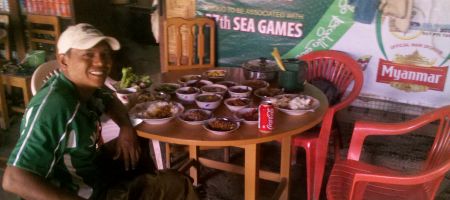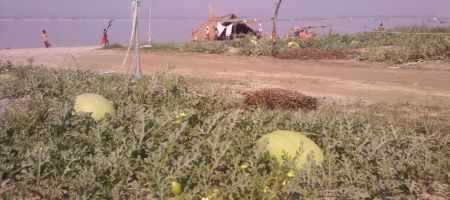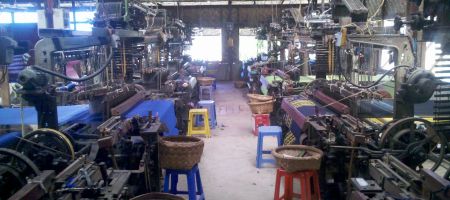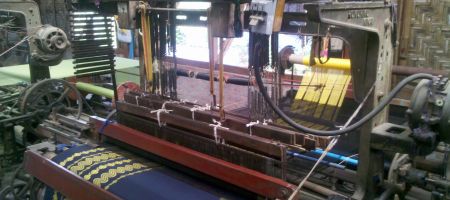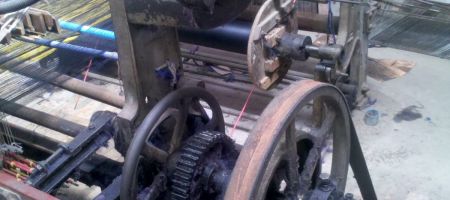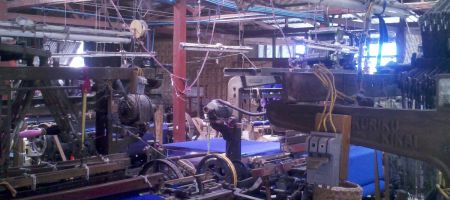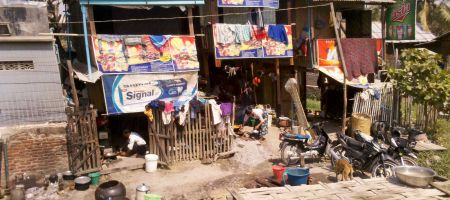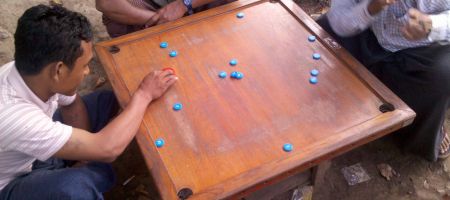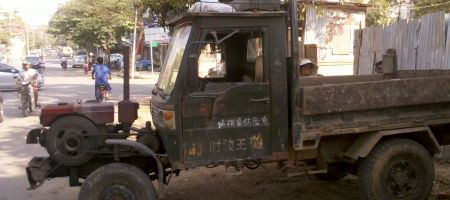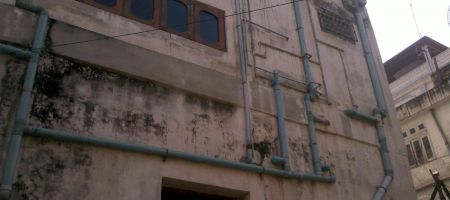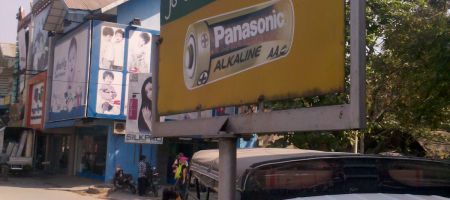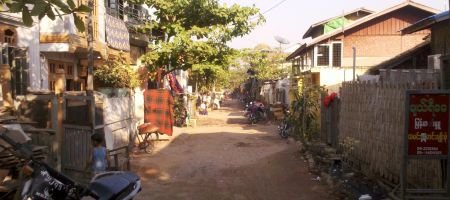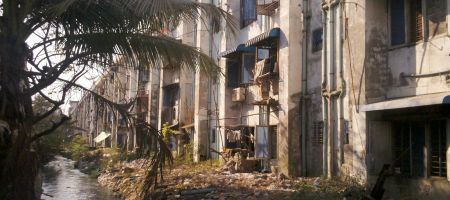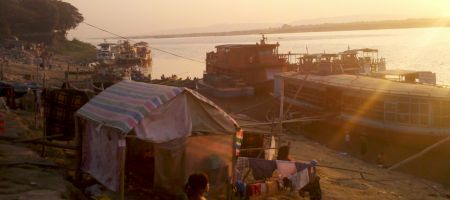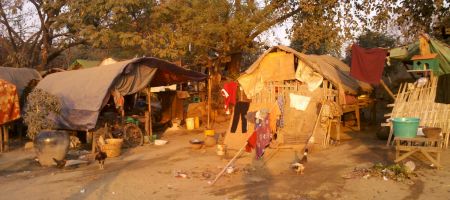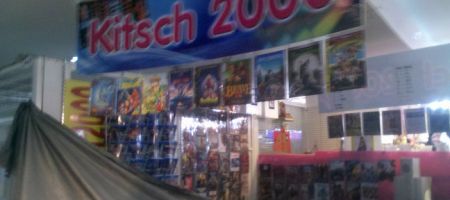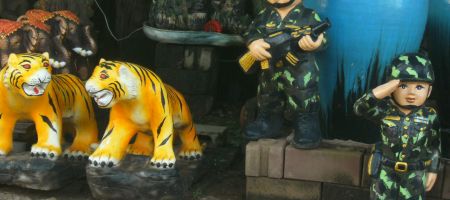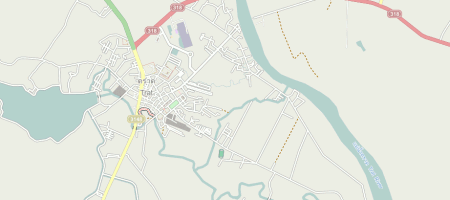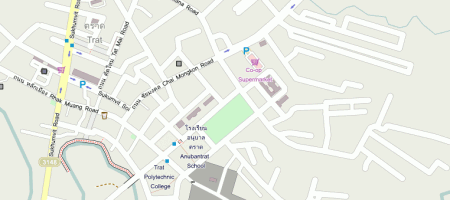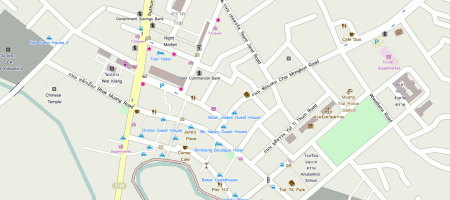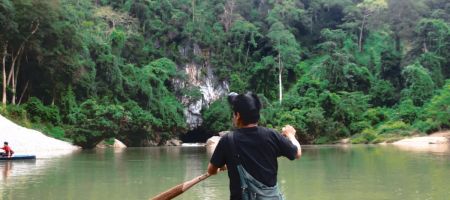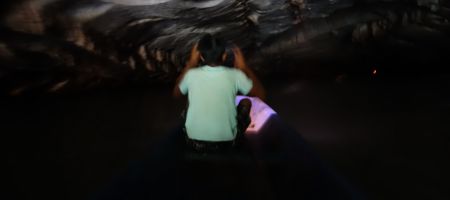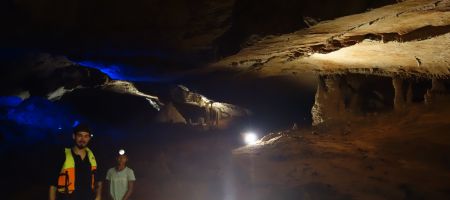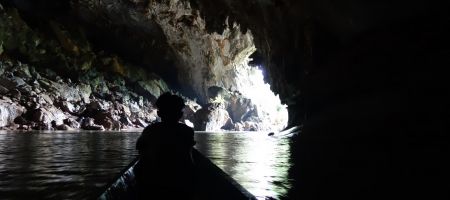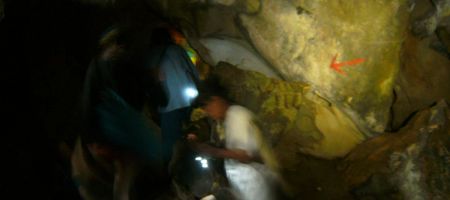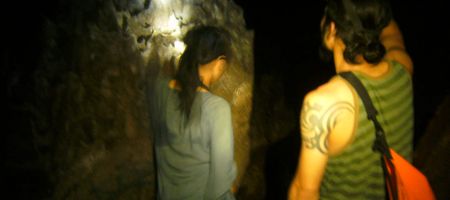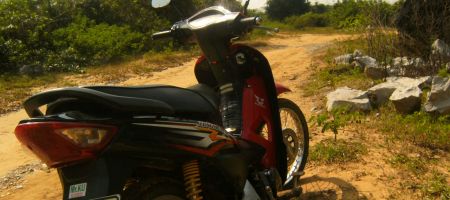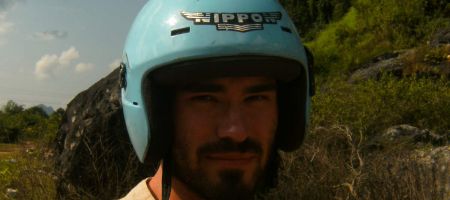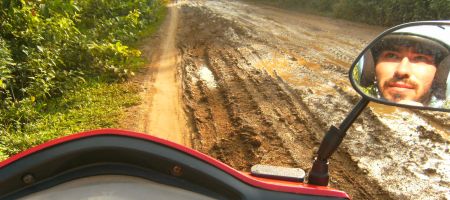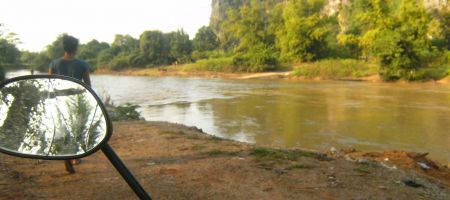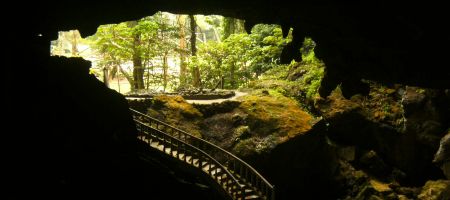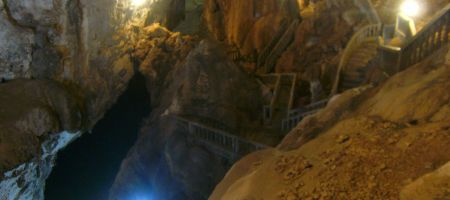In Myanmar, boogers are black
Funny facts with your host, Newton!
And also…
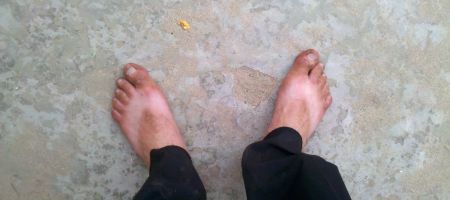
I got one of those famous “Burmese Sunburns” after a day on the motorcycle.
(Not to be confused with the famous “Farang tattoos”)
Comment [1]

Khaing Gyi and the textile factory
Meet Khaing Gyi. Khaing Gyi is 28 years old, comes from an extended family, is a family father with 2 children and currently earns his living as a motortaxi driver in Mandalay. His English is astoundingly good given that practically everything he knows about the language is what he taught to himself and in conversation with foreigners. He only ever went to primary school.
Many travelers who visit Mandalay rent a motorcycle with driver for a day for a flat rate of 15000 Kjat to visit some attractions in and around the town. So I happened to end up with him and it turned out to become an unforgettable experience: He quickly noticed that I am not that interested in seeing the classical tourist attractions, so he went to show me some of the local places as well.
Other than the tourist destinations, we drove through the countryside and through residential back-alleys, both of which are more interesting than they sound at first (just look at the previous article).
A British couple who are photographers made him a website. (And actually, he seems to have a second one. I wonder how that came together. Anyhow, the first one is the one he told me about.
If you go to Mandalay, say “hi” from me.
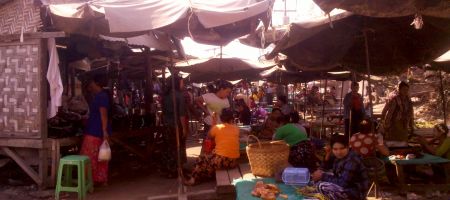
Just a market in the outskirts of Mandalay we stopped at on my request.
Along the river Ayeyarwady there are some melon farms in the tidal area of that river. Khaing Gyi told me that the 3 months or so of winter are the only time in which the area can be used agriculturally because during rain season, the area is flooded and during hot season, it is too dry for anything to grow. Otherwise, the ground seems to be perfect for melons. It is harvesting time now.
The highlight for me was this textile factory hidden in a back alley of some residential area, right next to a ruined chedi. This place was not even on his itinerary of the things he wanted to show me. We just got lost a bit on our way through Mandalay’s suburbs (which look like rural villages) when I heard a loud repetitive sound coming from inside some bamboo houses. When I asked about it, he said we could have a look and stopped. So that is how we got there.
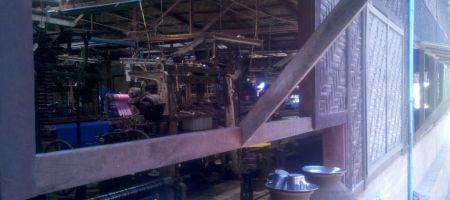
A view inside from one of the windows. The clay jugs you see outside in front is something typical for Myanmar. They are filled with drinking water and are a courtesy for thirsty passers-by.
The factories were quite small (perhaps 4×4 machines each), so small that they might be family businesses. Something I forgot to ask because I was too flabbergasted by the fact they’d just let us march into (and take photos of) their house/factory.
They didn’t seem to mind at all but at the same time didn’t show any obtrusive curiosity. This friendly prudence is something I came to like about the Burmese people. (After all, we are close to India here.)
The machines themselves could have been out of a museum. Cast iron and propelled by a single shaft (per row). But they were in a good shape, as far as I can tell.
Some more photos of the day trip with him:
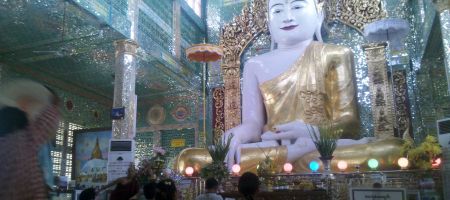
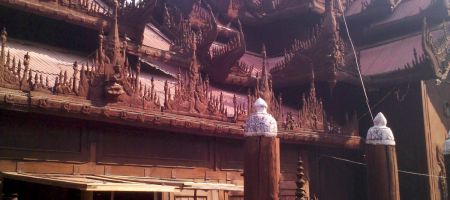
Buddhist temples in Burma look quite different from those in Thailand. Also, many temples are built traditionally out of wood. Just like the royal palace in Mandalay. It burned to the ground in WW2, though.
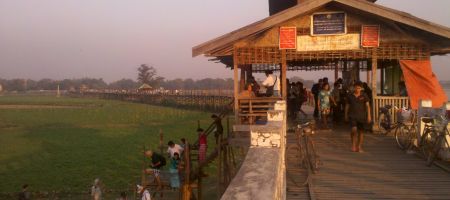
The U Bein Bridge, the longest and oldest teak wood bridge. (See nicer photos.) While I was on it, a supporting beam fell down and floated away. It is indeed very old.
Local fishermen at the same bridge. Those things they were carrying the catch in were their longyis (their trousers). Very versatile. :-)

Board game geeks II
This article is part of a series. Check out part I.
I made this picture in Mandalay, Myanmar.
The game is called Lattougkhon which a local translated to “Fingertouch” for me. It is very similar to Billiard, only that you play it by flicking with your fingers. Like all games that are played (at the streetside) in these countries, it’s of course played with money.
I had a go, and won against the local! Hoho! But we played without money ;-)
Otherwise, Ludo (“Mensch aergere dich nicht”) is quite popular here, as it is in almost all other countries I have visited so far. They don’t use traditional 6-sided dice but instead 6 small shells (as D2s) to roll. That makes a very memorizing sound, I like it :-)

First impressions of Mandalay
Here are some of my first impressions from Mandalay, Myanmar.
A lorry, made in Burma.
Seen on backside of a building in central Mandalay. Was tap water an afterthought here?
The newer street signs are apparently all sponsored by Panasonic. Regarding the street lighting, it seems that no sponsor has been found yet… ;-)
Because in Myanmar’s second largest city, there is none, not even in the center. It gives you an odd feeling to see that it is just 7 o’clock in the evening and the streets are pitchblack, only lighted by the lamps from inside houses and shops (and the cars).
Residential roads in central Mandalay. Many roads that are not main roads are unpaved, even in the city centre. Along the riverside are a few shanty homes built so close to the river that I think they will have to disassemble their homes before the next rain season and move further up or somewhere else. I am guessing the people there work on and about the boats which lie at anchor at the shore.

Burmese Days
It is time to revive this blog, for now, I am in Myanmar!
Actually, I already arrived more than a week ago, but I couldn’t write anything here because I took part in an intensive training in Vipassana meditation. The place had very strict rules, including absolutely no contact to the outer world, no sensual entertainment whatsoever (including reading, writing,…) and absolute silence. I finished this course now, so I can finally indulge myself into reading my emails and stuff like that.
More about that course later.
Myanmar is a fascinating country with kind people who all got a story to tell. So, stay tuned for my impressions.
Comment [2]

Kitsch2000
The Thai (and Laotians) have a hang for the cute and cheesy. The idea for this article came when I saw this in the MBK (big mall) in Bangkok:
Take this advertisment from 7-Eleven for some sausages for example. Cute, the little boy, isn’t he?
Have you seen the VIP buses yet? I mentioned them in a previous article.
The cheesyness in Thai culture does stop at nothing it seems. Traffic police boxes can easily be recognized by the giant plastic model of a police helmet that serves as its roof.
Even the military is not excluded: Like (some) Germans, Thais also like garden gnomes. They have a different style here, of course, but one of the popular shapes is a soldier-gnome. Here:
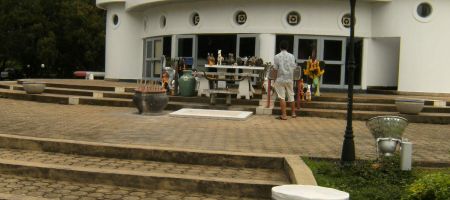
The above picture is of the Ko Chang Naval Battle Memorial (interestingly, the battle was a clear defeat on the Thai side, still if you don’t know the memorial looks something like a victory monument.)
Don’t see anything special in this thumbnail? Then click for the full image!
What about respectable monks in religion? Well, see this article about Thai religion (3rd picture). Though I have seen plenty “chibi”-monks, I have yet to encounter a Chibi-Buddha.

Mapping Trat - Before and after
When I first posted pictures of my mapping efforts for OpenStreetMap in this blog, I noted that it is kinda pointless to show those maps without a before-after view. But then again, you need to take screenshots of that before because the map does not have a powerful history function. This time, I didn’t forget doing that. So here we are (click the image for a full-sized version):
On this zoom level, the changes one can see are all almost exclusively traced from Bing satellite imagery. So to improve the map on this zoom level, no GPS is needed and there is no reason to actually be there. A map based on satellite imagery is a good basis for putting in more detail:
Detail like, most importantly (in my opinion) street names and larger areas which can’t be derived from the satellite imagery alone.
If a city is already mapped from satellite imagery on the above zoom level, it makes future GPS surveys much more effective because the surveyor can for example just walk down the main street and note down the names of the side-streets from the signs instead of having to walk up every alley to trace where it is leading or to see the extend of an area.
On OpenStreetMap, one can map almost everything. It is possible to map every shop, it is possible to map every building with housenumbers, storeys, type of roof, under construction or not, what type of building etc. etc.
Why?
Because everyone decides for himself what he deems important and what not. Also, the data on OpenStreetMap can be used for quite some different purposes, not only for GPS navigation. Perhaps the name is misleading, it should be called OpenWorldMap. And unlike in the Wikipedia, there are no “relevancy discussions”.
For example there is a project that strives to add the necessary information to the database to display the map in 3D.
So when surveying, I restrict myself to note down certain points of interests that I deem relevant for myself. Most importantly, street names, but also: banks, atms, post offices and boxes, pharmacies, supermarkets, guest houses, restaurants, bars and cafes, bus stands and stops, temples, schools, hospitals, marketplaces, public buildings and the like.
So, how complete is the map in your neighborhood?
Comment [2]

Tobi shows pictures of cars
In this post, I want to show you some more exotic vehicles I found while traveling through Thailand, Laos and Vietnam.
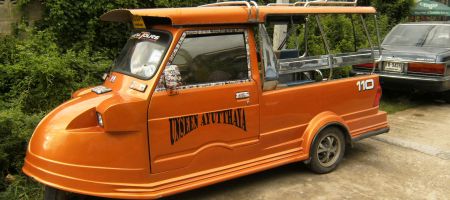
According to my research, this is the classical, old Tuk Tuk model that originated from Japan. Seen in Ayutthaya, Thailand.
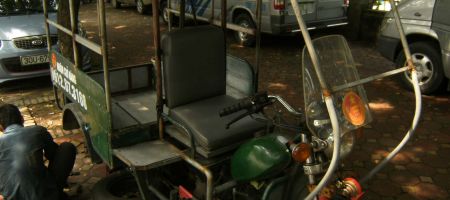
A Vietnamese auto rickshaw, a curiosity even in Vietnam. It looks much less like a Thai Tuk Tuk than like a Laotian Skylab.
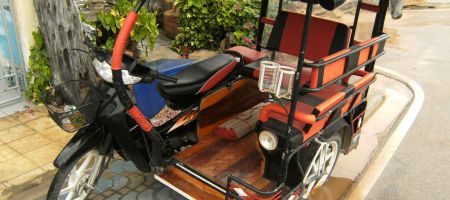
Also quite a rare construction is the motorcycle with a sidecart that is not dedicated as a cargo area but for person-transport like a Tuk Tuk. This one is a very nice specimen (note the cup holders) :-).
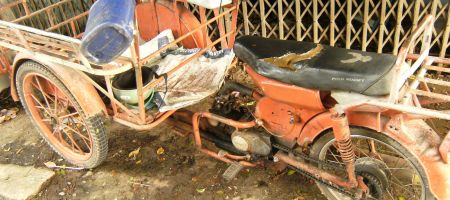
This crossbreed of a motorcycle and a pushcart is not a custom modification but a type of motorcycle. For some reason however they are always in such a shitty state. In Vietnam, side carts are much more popular than this construction.
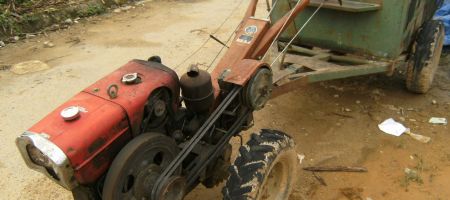
This “minimalist” tractor is all over South East Asia in rural regions. I remember seeing those things in Nepal as well.
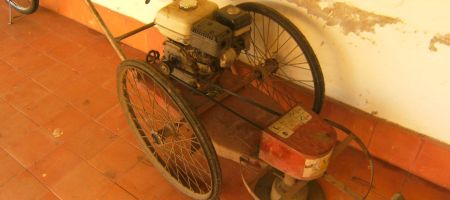
What is this, a gun carriage? Nope, it is a lawn mower :-).
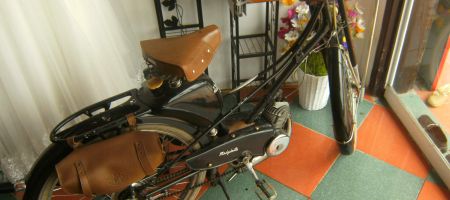
This oldtimer moped was standing in a shop that sold wedding dresses as a decoration in Vietnam. I saw it nowhere on the street though. Can you read the manufacturer? I’d be curious who once produced this.
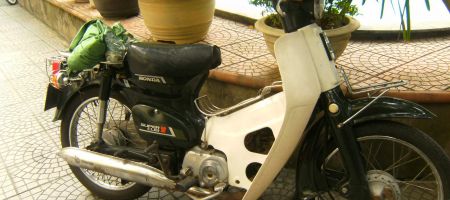
The Honda Super Cub 50, a classic. Apparently I am not the only one who fancies the design of this one. I have seen quite a few modern replicas of this out-of-production model from Chinese companies now.
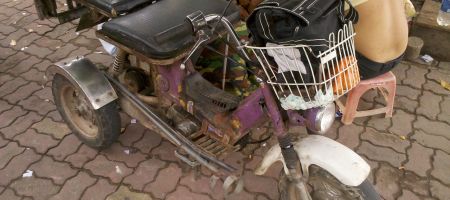
Also in Vietnam: This is a Honda Chaly, the small sister of the Honda Dream, modded into a tricycle. It is not seen too often on the streets of South East Asia but, fun fact, in contrast to the Honda Super Cub and Dream, this one was marketed in Europe as well.
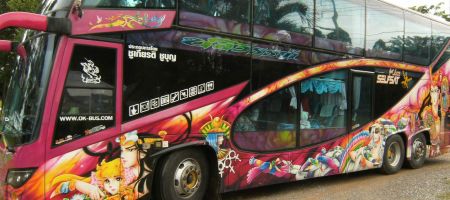
I reckon that I so far only posted pictures of motorcycles and the like.
Well, after all I was in Vietnam. For change, this is a typical Super VIP bus in Thailand. Most of the upper-class inter city buses are painted all over with cheesy anime motives and quite professionally so I have to admit.
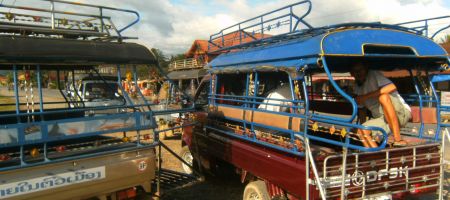
In Laos, Song Thaeos (Two rows) are the first (and in most places the only) option for public transportation around towns. They are what the name suggests: pickup trucks with a roof and two benches built in. They are also very common in Thailand.
Comment [1]

Spelunky
From Na Hin at route 8 about 40 km south there is Ban Cong Lor. Of the caves I have visited, Kong Lor Cave was the most impressing one. It is actually an underground river that connects Ban Kong Lor and Ban Natan each on different sides of a mountain range (see the map!). The cave is about 8 km long and it’s dimensions are breathtaking. Dimensions of which I thought before would only exist in movies; It really boost your imagination.
While going into the mouth of the cave, I fantasized about the cave being a giant ancient (petrified) monster. Later deeper in the cave, it was easy to imagine whole settlements alongside the riverbank, like the dwarves’ caves of the Lord of the Rings movies. To quote the Lonely Planet, often the ceiling really is church-high.
What puzzles me though is that at one point I saw a trunk of a tree stuck in the ceiling in a height of about 5-10 metres. How did it get there? It seems unrealistic that the river can rise to that height, given that I already visited the cave in the (end of) rain season.
In the same valley, we also just walked around near the village one afternoon and stumbled upon another (small, “normal-sized”) cave that we wanted to explore after fetching our headlights from the guesthouse. Though, after 50 metres into the cave or so and one flipflop lost later, we gave up. It was just too muddy, slippery and tight. According to the neighbour, it is called Porcupine Cave (translated) and there ought to be an exit some 100 metres from the entrance.
Deservedly but sadly as it will transform this tranquil and authentic village somewhat, the development of this cave will bring Ban Kong Lor a tourist boom in the short future. A paved road has been finished to the village a few years ago(?) and now there is even a direct tourist bus from Vientaine.
Otherwise, it’s surrounding landscape with it’s rice fields in the flatland and steep mountains surrounding the valleys is somewhat similar to that near Vang Vieng, which is also famous for it’s many caves (amongst other things)
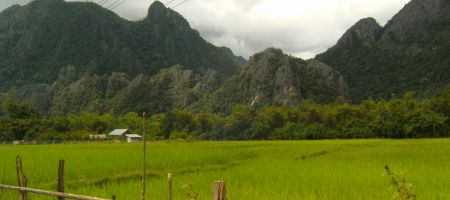
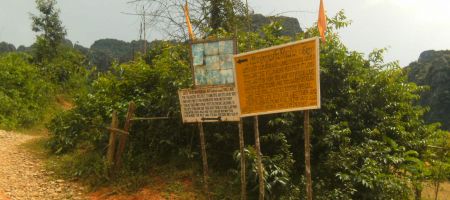
These pictures are from Vang Vieng
One particularly interesting cave near Vang Vieng one is Tham Phu Kam. With Kong Lor Cave mentioned in the same article, it is hard to use superlatives, but… well, every cave is unique. And even though it might not be, this cave feels quite untouched: Except for a few painted red arrows and one “Danger” sign in front of a bottomless pit inmidst the cave (not so much as a rail), there is nothing that guides one through there.
One is on his own and for a cave as big as this, it is a exciting experience to explore it.
Danger sign and the pit. I didn’t find a pebble.
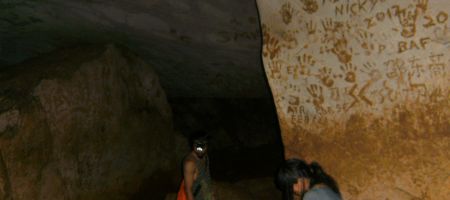
Spelunker graffiti in/below the second cavern written in mud. Let me make a hypothesis here: §1 – In every graffitied place, there exists at least one penis.
The way in this cave is quite unclear. The cave is to a certain extent 3D and there seem to be several caverns branching off in different directions, not sure though and not sure if they’d be big enough for a human. The main way continues over several (three) “Kong Lor-huge” caverns into absolute darkness, meeting an underground stream further down. It looked like it would be possible to go even further into the cave by following the underground stream but we’d have had to cross the muddy stream first and we were too afraid to do that in our flipflops and no gear except headlights.
Also, did you know that the eyes of big cave spiders reflect light like tiny little reflectors? The reflection can be mistaken as a drop of water. Stuff that suddenly jumps from you won’t be spiders though but some kind of cave crickets.
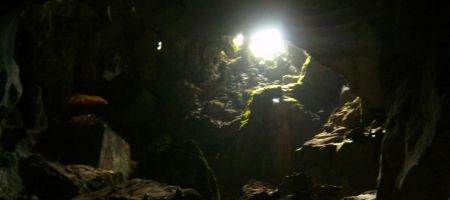
Out again. The first cavern receives sunlight from a hole in the ceiling. (The gold roof to the left contains a roughly human-sized reclining Buddha).
Comment [1]

Muddy Roads
Being a geographically big but scarcely populated and otherwise quite agrarian country, Laos has not much to offer for the sightseeing tourist.
The few towns there are, are all in the relative lowland, glued to the riverbank of the Mekong river which for the major part forms the boundary between Thailand and Laos. The town centres are all surprisingly compact.
The rest of the country is mostly mountains, jungle or both.
So apart from taking in the relaxed city centres in their colonial atmosphere, what makes Laos appealing to visit is it’s vast untouched nature, and in terms of sights, natural wonders like waterfalls, caves and the like.
And so the most impressive caves I have seen so far have all been in Laos.
Getting there is part of the adventure as (local) public transportation is somewhat scarce or inaccessible. For most caves, an own vehicle is essential.
Whenever I rented a motorbike in Laos, it was always the above model, a 4-geared Chinese-made clone of the popular and reliable Honda Wave that apparently only costs half of what the Honda costs. Well, I actually can’t say anything about the reliability of the Wave but it can be only more reliable than the Zongshen version: Each time I rented this model I found out that something was not working right. One time it was the light, clutch (just needed more force to change) and speedometer1, another time it was the fuel tank display and the rear break (wouldn’t loosen after braking). But I am not complaining, for thirty to fifty thousand kip a day (3-5€) I don’t expect they rent out anything better maintained than what normally goes on the streets in Laos.
By the way: Honda Wave and the like are not scooters. The most important differences being that they have gears (semi-automatic), that you sit on it like on a motorbike (left foot changes gears, right foot is the rear brake) and that they have better suspension with proper sized wheels which makes them eligible for the countryside. This motorbike design seems to be utterly unknown in Germany, closest relatives are the mopeds or mokicks, while on the other hand, the standard motorbike design we know is quite rare here.
So, there are a couple of caves near Tha Khaek, though I had to learn that most are not accessible during rain season (end of September). Well, at least not with a motorbike – perhaps with a 4WD.
Except for the most important national “highways”2, most of the roads in Laos are dirt tracks or compacted roads. Needless to say they can become so muddy during rain season that they are rendered unusable for anything more civilian than Landrovers and the like.
For half an hour or so I had to go through this section of an otherwise good compacted road en route to “Buddha Cave”. (It feels as if half of the caves in Laos do have this name.)
Another obstacle are rivers. Just 50 metres in front of where I took this photo, a sign said “Elephant cave this way, 300m”. Most (all?) fords are not accessible during rain season. (Also, it feels like the other half does have this name ;-))
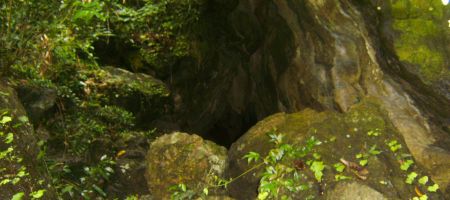
Speaking of rivers: I couldn’t get into this cave because the water flowing out of this cave was too high.
Finally at a cave that I could access, a view to the entrance. This kinda reminds me of a particular loader screen for Clonk Rage.
This cave is quite developed, but that’s okay. There are enough others that are left untouched and for this cave, it really adds to the atmosphere. Below is an underground river, but the tide was too high to get to the boats. Rain season.
Stay tuned for the second part of this article!
1 Not implying that 90% of all speedometers in Laos are not broken anyway.
2 Even though they call it highway, for me, a non-segregated road that has only one lane in each direction with foodstalls, pedestrians and bicycles occupying the sides of it does not qualify as a highway.

